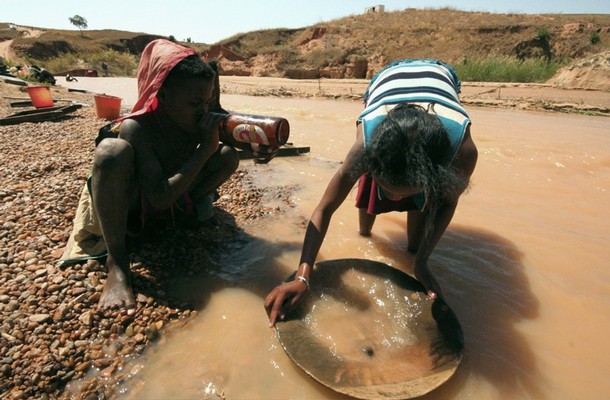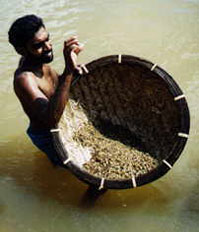The rarest and most valuable fancy color sapphires are the exquisite orangy-pink or pinkish-orange gems referred to as "Padparadscha" after the Sinhalese word for lotus blossom. The exact color has always been a matter of debate: different dealers and different laboratories around the world disagree on the exact color described by this term. Perhaps this is partially because the lotus blossom itself can have a range of color shades. Natural padparadscha sapphires (sometimes called pads) sell at a premium, nearing the price for a fine blue sapphire. Prices of several thousand dollars per carat are not unusual. Although the exact color description is debated, the beauty of these rare gemstones with their delicate blended pink and orange shades is universally esteemed. Found originally in Sri Lanka, pads have become collectors' items which are bought up as quickly as they are found.
The prices and value of padparadscha sapphire vary depending on the size and quality of the gemstone. Unheated specimens are especially valuable. Simple heat treatment is accepted, but sapphires which have achieved a padparadscha-like color by means of diffusion treatment with beryllium are not regarded as genuine padparadscha. Most padparadschas have a pastel color, and there is some debate whether the more vivid orange-pink colors should be termed padparadscha. There is general agreement that a padparadscha should display a color which is a mix of orange and pink, rather than exhibit color zoning with orange and pink regions
Why Buy Loose Gemstones Instead of Pre-Set Jewelry? There are many reasons, but basically it comes down to value and choice...
When buying your gemstone loose instead of a pre-set stone, you can be sure you are getting the best value for your money. Loose gemstones are less expensive, a better value, and you can really see what you are paying for. The most important part of getting the right price and finding the best value is to first see what you're getting. A jewelry setting will hide the inclusions inside a gem, and can deepen or brighten its color. With a loose stone you can much more easily inspect the gem and see it for what it really is. In this way you can get a better idea of its true worth and be sure you are paying a fair price.
The second advantage of buying a loose gemstone is choice. You are free to pick the exact color, cut, shape and variety of the stone for the setting of your dreams, be it yellow gold, white gold, platinum or silver; prong set or bezel set. You can experience the joy of creating your very own, one-of-a-kind jewelry design. Choose from a variety of jewelry settings and styles to create a completely original presentation that will perfectly suit your individual gemstone and will be as unique as you are!
Attributes
Padparadscha sapphire's enchanting color is just one reason for this gemstone's popularity. As with all sapphire, it's also extremely durable, having a hardness of 9 on the Mohs scale. Sapphire has a specific gravity of 4.00, a refractive index of 1.76 - 1.78, and birefringence of 0.008; The refractive index (RI), measured using a refractometer, is an indication of the amount light rays are bent by a mineral. Birefringence is the difference between the minimum and maximum RI. When birefringence is high, light rays reflect off different parts of the back of a stone causing an apparent doubling of the back facets when viewed through the front facet.
Most gems have a crystalline structure. Crystals have planes of symmetry and are divided into seven symmetry systems. The number of axes, their length, and their angle to each other determine the system to which a crystal belongs. The gem Padparadscha sapphire is classified as having a trigonal crystalline structure because it has three planes of symmetry and four axes. Three axes are at 60 degrees to each other in the same plane. The fourth axis is perpendicular and unequal in length to the other three. The form of a sapphire's crystals depends on the variety and locality. Sapphires may have an uneven or a conchoidal fracture but no real cleavage. The amount of light reflected at the surface of a gemstone is its luster and Padparadscha sapphires have a glassy (vitreous) luster as opposed to the waxy, greasy, or resinous luster of other stones.
Color
Padparadscha Sapphire (or Pad) is valued for its attractive color. For most sapphires, the more saturated the color, the more valuable the gem. With padparadschas, a medium saturation is often highly regarded, since these gems are expected to be pastel in color and tone.
Ovals, rounds, cushions and emeralds are the most common cuts for sapphire, due to the typical shape of sapphire rough. Other popular sapphire shapes include pears, hearts and marquises.
Treatments
The traditional heating of ruby and sapphire is a widely used and is an accepted enhancement process which can improve the transparency and color of the stones. Padparadschas are often heated as well. But the beryllium diffusion process used to color some orange and yellow sapphires cannot be used to produce a genuine padparadscha, since the subtle color must be natural.
Sosnagems fully discloses any and all treatments to our gemstones.
Padparadscha sapphires have traditionally come from Sri Lanka. More recently some sapphires in this rare color have been found in Tanzania and Madagascar.
Madagascar


In the early 1990's, a new source of gem quality sapphire stunned the international gemstone market. Madagascar, a large island nation off the south-east coast of the African continent, became the hottest news in the precious gem industry. With just a few years of development, several new mine sources began producing commercial to top gem quality sapphires the likes of which had not been seen for over a century.
Buyers from around the globe flocked to the new finds. Once small villages of a few dozen mud huts soon became wild west boomtowns with 10's of thousands of new inhabitants. Most of the newcomers were itinerant miners looking to strike it rich in the pay dirt of the Madagascar wilderness. Dirt poor farmers could become instantly wealthy by local standards with the find of just one exceptional rough sapphire crystal.
These new African deposits have been a boon to sapphire traders everywhere in the world. There is now a whole new range of beautiful blue gemstones available to gem dealers, jewelers and collectors, many of which are often compared with Ceylon sapphire. The color saturation, clarity, evenness and purity of color occasionally rival the finest of Burma and even the elusive sapphires of Kashmir.
Production from Kashmir has been virtually nothing for the past several decades, making fine sapphires from this source nearly impossible to find. Burma however, does continue to produce excellent quality sapphires to this day, but in very small quantities.
The wonderful advantage to modern day sapphire lovers is the relative availability of Madagascar gems at affordable prices. Madagascar has made the dream of owning a Kashmir look-alike possible to a wide range of gem lovers around the world.
Ilakaka and Sakaraha are situated a little south of the island Madagascar near a place called Toliara or Tulear. Since its discovery in 1998, the mine has seen active mining and trading from all over Madagascar is conducted here. Go past the desert southwards and you will reach a place called Andranondambo. Known at one time as Fort Dauphin, Tolanaro is a metasomatic sapphire mining area for blue sapphires where, in 1994 the first sapphires of gem quality were found.
Sri Lanka
Mining on the island of Sri Lanka goes back at least 2000 years. This island has its own heritage in the mining arena. The island is called Gem Island or "Ratna Dweepa" because of the large variety of gems found here. You will find everything from peridot to moonstones to garnets and topaz. Today Sri Lanka is best recognized for it's the sapphires called the Ceylon Blue, and the sapphire called Padparadscha which has a beautiful and unique orange pink pastel soft color, very similar to the Lotus flower found on this island. The traditional Ceylon mines are near Ratnapura which is located southeast of Colombo about 100kms away.
Sri Lanka is still one of the world’s largest sources of fine quality blue sapphire. It is a place where one can regularly find excellent gems over the 100 carat mark. Many of the famous large sapphires in museums around the world came from this gemstone rich tropical island. Sri Lanka is also a very well known source for fine quality star sapphires, as well as yellow and pink sapphires.
The classic “cornflower blue” is what Sri Lanka is best known for. The finest of the sapphires from Ceylon are a very even and intense pure blue color, with a high degree of saturation. This bright and medium toned shade of blue is highly prized around the world, and is considered to be far superior to the often overly dark and inky colors commonly found in Australia and Thailand.
The area know as Ratnapura sits right in the middle of the gem producing area of Sri Lanka. Surrounding this town one can see hundreds of small to large hand dug pits where the gemming (Sri Lankan term for gem mining) is going on. The government has put a total ban on mechanized mining, thereby assuring a tight supply, stable prices, and a source of income for many future generations of poor indigenous laborers.
Burma
Burma, which is today called Myanmar, has several important locations that produce sapphire. The most famous is the Mogok gem tract which has a rich history of production dating back several hundred years. Sapphires from Burma were not recognized for their superior quality until the 1950's, after which their value and demand has risen dramatically.
But what exactly is it that makes blue sapphires from Burma so superior to gems from any other location? In visual terms it is what is known as color saturation. Burmese sapphires possess some of the very highest concentration of blue color possible. The only way to properly understand this is to see the very best of Burmese sapphires side by side with the best from any other source in the world.
The myths, legends, beliefs, superstitions, traditions and symbolism associated with sapphire have been numerous...
Legend has it that the first person to wear Sapphire was Prometheus, the rival of Zeus, who took the gemstone from Cacaus, where he also stole fire from heaven for man.
Known as the "Gem of Heaven", the ancient Persians believed Sapphires were a chip from the pedestal that supported the earth, and that its reflections gave the sky its colors.
Tradition holds that Moses was given the Ten Commandments on tablets of sapphire, making it the most sacred gemstone. Because blue sapphires represent divine favor, they were the gemstone of choice for kings and high priests. The British Crown Jewels are full of large blue sapphires, the symbol of pure and wise rulers.
The guardians of innocence, Sapphires symbolize truth, sincerity and faithfulness, and are thought to bring peace, joy and wisdom to their owners. In ancient times it was believed that when the wearer of a Sapphire faced challenging obstacles, the gem's power enabled them to find the correct solution.
In India it was believed that a Sapphire immersed in water formed an elixir that could cure the bite of scorpions and snakes. Alternatively, if it were worn as a talisman pendant, it would protect the wearer against evil spirits.
The following legend is Burmese in origin and highlights Sapphires‘ connection with faithfulness: “Eons ago Tsun-Kyan-Kse, a golden haired goddess with Sapphire blue eyes, presided lovingly over the temple of Lao-Tsun. Everyday, the temple‘s chief monk Mun-Ha, meditated before the golden goddess accompanied by his devoted companion, a green-eyed cat named Sinh. One day the temple was besieged by a group of terrible outlaws. When they threw Mun-Ha to the floor, Sinh leapt fiercely at the bandits, jumping up on his master‘s chest to protect him. The wrong doers fled screaming in fear, never to return and in gratitude for his courage, the golden goddess awarded Sinh with her Sapphire blue eyes. To this day, Sinh‘s ancestors guard over the temple.” The temple still stands and is populated by Siamese cat‘s with striking blue eyes (typically this breed has green eyes).
For hundreds of years Blue Sapphires were the popular choice for engagement and wedding rings.





